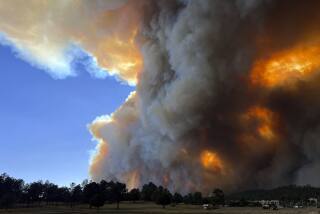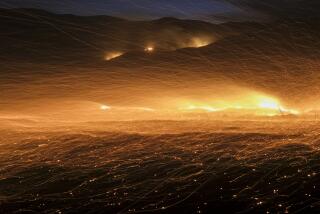Mexican Fires May Burn Into July, Group Says
MEXICO CITY â This nationâs forest fires could rage into July, extending a catastrophe that has threatened endangered species and sent smoke drifting from southern Mexico to the northern plains of the United States, a delegation sent by President Clinton declared Friday.
The bleak assessment from the U.S. delegation came as President Ernesto Zedillo asserted that Mexico is experiencing a âtrue ecological tragedyâ caused by the hundreds of fires that have ravaged tropical rain forests and shrouded cities in smoke.
The U.S. delegation, led by Agriculture Secretary Dan Glickman, said most of the blazes were caused by farmers setting fires to clear fields before the traditional rainy season. A drought prompted by the El Nino weather phenomenon had so dried the underbrush that the fires quickly spread out of control in Mexico and Central America.
âThis disaster in Mexico has to be the most serious of its kind weâve seen in the world, including in Indonesia, and the most difficult to deal with,â said J. Brian Atwood, a member of the U.S. delegation sent to investigate the crisis.
But the Mexican president said peasants werenât the only culprits.
âThere have been fires caused by drug traffickers,â apparently to clear land for illegal crops, Zedillo said in a speech. He vowed to block traffickers from moving into devastated areas to plant marijuana or poppies.
The damage from the blazes has gone beyond the clouds of smoke that have billowed over the U.S. border. Fires are eating away at the Chimalapas tropical forest in southern Oaxaca and Chiapas states, home to 1,500 of the worldâs most endangered species.
Atwood told a news conference that 130 of the 150 most-used pharmaceuticals in the United States include ingredients from plants found in the burning tropical forest.
The fire damage âis deeply troubling when you consider the value of these plants, both real and potential,â said Atwood, administrator of the U.S. Agency for International Development.
A 41-member U.S. Forest Service team is helping thousands of Mexican firefighters, soldiers and volunteers extinguish the blazes.
The U.S. government has also provided almost $8 million to Mexico to equip 3,000 firefighters, send helicopters to dump water over the fires and spot new blazes. More aid will be announced next week when the U.S. and Mexican cabinets meet in Washington, the U.S. officials said.
But they acknowledged that there is no quick end in sight to the fires because meteorologists are predicting that heavy rains will not arrive until July.
*
What makes the firefighting job so difficult is that many blazes are in remote forests and ravines. Firefighters often must walk for hours to even reach the flames; thick smoke curling from parchment-dry underbrush is preventing helicopters from reaching burning cloud forests.
Sixty-one Mexicans have died battling the blazes.
Environmentalists and politicians have criticized the efforts to fight the fires, which have swept 1,500 square miles this year.
Homero Aridjis, who heads the Group of 100 environmental organization in Mexico City, said in an interview that Mexican authorities had reacted too slowly and had been too reluctant to accept U.S. assistance. As for the U.S. aid, he said, it was âtoo little, too late.â
The U.S. delegation vigorously contested that assessment. Members said the Mexicans had aggressively tackled the blazes but had simply been overwhelmed by fires set in May.
When U.S. officials realized a catastrophe was in the making, Atwood said, âwe moved as quickly as we could.â
The officials noted that the number of major fires has declined from a late-May peak of 277 to the current 143.
Still, Atwood acknowledged that senators in Texas, which has declared health alerts because of the smoke, had gotten the U.S. government recently to speed up its aid.
âThereâs no question the politics of the issue was a factor in accelerating our response,â he said.
Mexicoâs environment ministry announced Friday that during the upcoming rainy season it would reforest about 300 square miles of land damaged by the blazes.
Mexico City declared a pollution emergency Friday because of the soaring levels of ozone from car and factory emissions trapped in the mountain-ringed capital. The government ordered half the cityâs autos off the road today, in the sixth such emergency day in the last two weeks.
More to Read
Sign up for Essential California
The most important California stories and recommendations in your inbox every morning.
You may occasionally receive promotional content from the Los Angeles Times.










